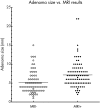Outcome of surgical treatment of 200 children with Cushing's disease
- PMID: 23372173
- PMCID: PMC3590477
- DOI: 10.1210/jc.2012-3604
Outcome of surgical treatment of 200 children with Cushing's disease
Abstract
Context: Factors influencing the outcome of surgical treatment of pediatric Cushing's disease (CD) have not been fully established.
Objective: The aim of this study was to examine features influencing the outcome of surgery for pediatric CD.
Design: In this prospective observational study, the clinical, imaging, endocrinological, and operative outcomes were analyzed in consecutive patients treated at the National Institutes of Health (NIH) from 1982 through 2010.
Setting: The study was conducted in a tertiary referral center.
Results: Two hundred CD patients (106 females, 94 males) were included. Mean age at symptom development was 10.6 ± 3.6 years (range, 4.0 to 19.0 y). Mean age at NIH operation was 13.7 ± 3.7 years. Twenty-seven patients (13%) had prior surgery at another institution. Magnetic resonance imaging identified adenomas in 97 patients (50%). When positive, magnetic resonance imaging accurately defined a discrete adenoma in 96 of the 97 patients (99%), which was more accurate than the use of ACTH ratios during inferior petrosal sinus sampling to determine adenoma lateralization (accurate in 72% of patients without prior surgery). A total of 195 of the 200 patients (98%) achieved remission after surgery (189 [97%] were hypocortisolemic; 6 [3%] were eucortisolemic postoperatively). Factors associated with initial remission (P < .05) included identification of an adenoma at surgery, immunohistochemical ACTH-producing adenoma, and noninvasive ACTH adenoma. Younger age, smaller adenoma, and absence of cavernous sinus wall or other dural invasion were associated with long-term remission (P < .05). A minimum morning serum cortisol of less than 1 μg/dl after surgery had a positive predictive value for lasting remission of 96%.
Conclusions: With rare disorders, such as pediatric CD, enhanced outcomes are obtained by evaluation and treatment at centers with substantial experience. Resection of pituitary adenomas in pediatric CD in that setting can be safe, effective, and durable. Early postoperative endocrine testing predicts lasting remission. Because lasting remission is associated with younger age at surgery, smaller adenomas, and lack of dural invasion, early diagnosis should improve surgical outcome.
Figures





Similar articles
-
Prospective evaluation of the characteristics and incidence of adenoma-associated dural invasion in Cushing disease.J Neurosurg. 2012 Feb;116(2):272-9. doi: 10.3171/2011.8.JNS11456. Epub 2011 Sep 16. J Neurosurg. 2012. PMID: 21923247 Free PMC article.
-
Dynamics of postoperative serum cortisol after transsphenoidal surgery for Cushing's disease: implications for immediate reoperation and remission.J Neurosurg. 2018 Nov 1;129(5):1268-1277. doi: 10.3171/2017.6.JNS17635. Epub 2017 Dec 22. J Neurosurg. 2018. PMID: 29271716
-
Negative surgical exploration in patients with Cushing's disease: benefit of two-thirds gland resection on remission rate and a review of the literature.J Neurosurg. 2018 Nov 1;129(5):1260-1267. doi: 10.3171/2017.5.JNS162901. J Neurosurg. 2018. PMID: 29219752 Review.
-
Factors influencing the outcome of microsurgical transsphenoidal surgery for pituitary adenomas: a study on 184 patients.Hormones (Athens). 2013 Apr-Jun;12(2):254-64. doi: 10.14310/horm.2002.1409. Hormones (Athens). 2013. PMID: 23933694
-
Neurosurgical treatment of Cushing disease in pediatric patients: case series and review of literature.Childs Nerv Syst. 2019 Nov;35(11):2127-2132. doi: 10.1007/s00381-018-4013-5. Epub 2018 Nov 28. Childs Nerv Syst. 2019. PMID: 30488233 Review.
Cited by
-
Treatment of Cushing's Syndrome: An Endocrine Society Clinical Practice Guideline.J Clin Endocrinol Metab. 2015 Aug;100(8):2807-31. doi: 10.1210/jc.2015-1818. Epub 2015 Jul 29. J Clin Endocrinol Metab. 2015. PMID: 26222757 Free PMC article.
-
High-resolution(18)F-fluorodeoxyglucose positron emission tomography and magnetic resonance imaging for pituitary adenoma detection in Cushing disease.J Neurosurg. 2015 Apr;122(4):791-7. doi: 10.3171/2014.10.JNS14911. Epub 2014 Dec 5. J Neurosurg. 2015. PMID: 25479121 Free PMC article.
-
Corticotropin releasing hormone can selectively stimulate glucose uptake in corticotropinoma via glucose transporter 1.Mol Cell Endocrinol. 2018 Jul 15;470:105-114. doi: 10.1016/j.mce.2017.10.003. Epub 2017 Oct 3. Mol Cell Endocrinol. 2018. PMID: 28986303 Free PMC article.
-
Potential utility of FLAIR in MRI-negative Cushing's disease.J Neurosurg. 2018 Sep;129(3):620-628. doi: 10.3171/2017.4.JNS17234. Epub 2017 Oct 13. J Neurosurg. 2018. PMID: 29027863 Free PMC article. Clinical Trial.
-
Pediatric Cushing Syndrome: a unique account of a rare but important condition.Transl Pediatr. 2024 Jul 31;13(7):1283-1286. doi: 10.21037/tp-24-170. Epub 2024 Jul 29. Transl Pediatr. 2024. PMID: 39144419 Free PMC article. No abstract available.
References
-
- Magiakou MA, Mastorakos G, Oldfield EH, et al. Cushing's syndrome in children and adolescents. Presentation, diagnosis, and therapy. N Engl J Med. 1994;331:629–636 - PubMed
-
- Styne DM, Grumbach MM, Kaplan SL, Wilson CB, Conte FA. Treatment of Cushing's disease in childhood and adolescence by transsphenoidal microadenomectomy. N Engl J Med. 1984;310:889–893 - PubMed
Publication types
MeSH terms
Substances
Grants and funding
LinkOut - more resources
Full Text Sources
Other Literature Sources
Medical

